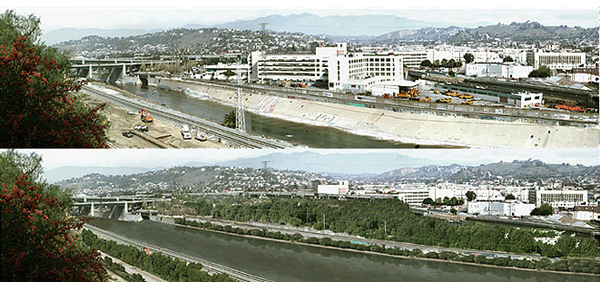So much about the Los Angeles River is not immediately obvious. That it’s a river at all, for example, still comes as a surprise to some. Others wonder when it will ever get the help it needs to really look like a river. The natural river was at least 80 percent ground water. Now there’s no groundwater to speak of, and the river we have is mostly recycled sewage—surprisingly clean tertiary treatment plant water running down a straight concrete shell. There’s simply not enough available real estate to free it from the channel and let it wander like a river would, and no matter how right we are that it is a river, it will remain provisional and abstract in the way it represents itself. What is strange is how attractive it can be once you get to know it—like an oddly cantankerous family member who manages, against all odds, to garner affection.
Okay, affection is not quite the word. But what word would adequately explain the force behind poet Lewis MacAdams’ impossibly successful 30-year effort to fix it, by first cutting a hole in a chain-link fence? What would explain the tall, thin, bald, shaven couple Osseus Labyrint, who suspended themselves naked from cables under the First Street Bridge, or the New Zealand artist Brett Goldstone who built quasi-legal river powered turbines in the channel?

SCI-Arc Veritcal Studio rendering of inflatable rubber dam near the Spring Street Bridge, ©Lane Barden
There was the young Dane, now better known as Olafur Eliasson, who, back in ’99, dumped half a shoebox full of intense but harmless dye in the river to turn it a sweeping, shocking bright green. (He said no one noticed). And I cannot explain even to myself, the two or three years of energy and professional capital I spent trying to convince anyone who would listen, that what we needed was a computer operated inflatable dam in the channel to make a seasonal waterway for performance barges and a floating beer garden. There are countless other art stories, far too many to mention here.
On June 29, 2016 the City Council voted unanimously to adapt the environmental impact study for Alternative 20—the ambitious proposal introduced exactly 10 years ago to restore 11 miles of the Los Angeles River. It was the final act before the planning and initiation of actual changes could begin. It was a huge victory for Lewis MacAdams’ Friends of the Los Angeles River, the city, and the environment.
But it would be inaccurate to describe this achievement as a purely environmental and political one. Lewis conceived of it from the beginning as a “40 year artwork.” He has consistently and patiently made a place for artists within it every step of the way. Developers, politicians and environmentalists were included along with everyone else.
The uncomfortable irony is that FoLar’s remarkable success will convert this raw, renegade no-mans’ land, a place for dreamers, misfits and artists, into prime real estate with a generous helping of luxury condominiums. With this in mind, the vast, surreal theater of concrete in the channel through downtown is beginning to look historical and iconic, like something that cannot be surpassed by a contoured landscape, carefully planned with turf, trees, and comfortable venues.

L.A. River before and after installation of an inflatable rubber dam at the Spring Street Bridge, ©Lane Barden
What to make of this massive concrete artifact that drew so many into it and into action? In the study of dynamic systems, a strange attractor is a complicated initial condition that orders and patterns everything that follows in an otherwise chaotic and unpredictable way, while it creates mathematical vectors that render beautifully strange abstractions. I know nothing about chaos theory or fractal geometry, but I know from experience that this sounds a lot like the LA River and the massive effort it took to get this done.
Chaos and unpredictability were woven into it like an intricate conduit of water, birds, fish, artists, flood control, power relations, river denial, legal wranglings, environmentalists, community objections and support, railroads, endless meetings, high tension wires, engineering, history, and an unending flow of dialogue about a river so implacably constrained and concretized, that to have now come to a deep breath of freedom and a turning point can only be described as a miracle. The struggle to draw the river back into its rightful place in the world is over. For better and for worse, let the restoration begin.


